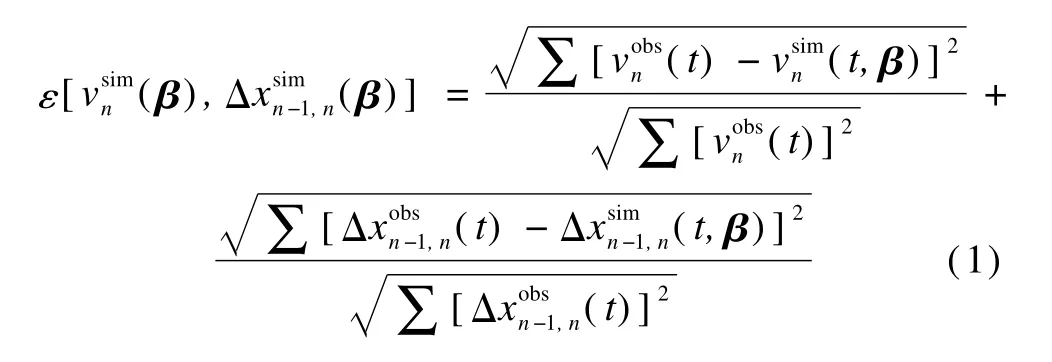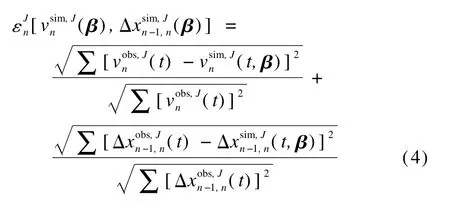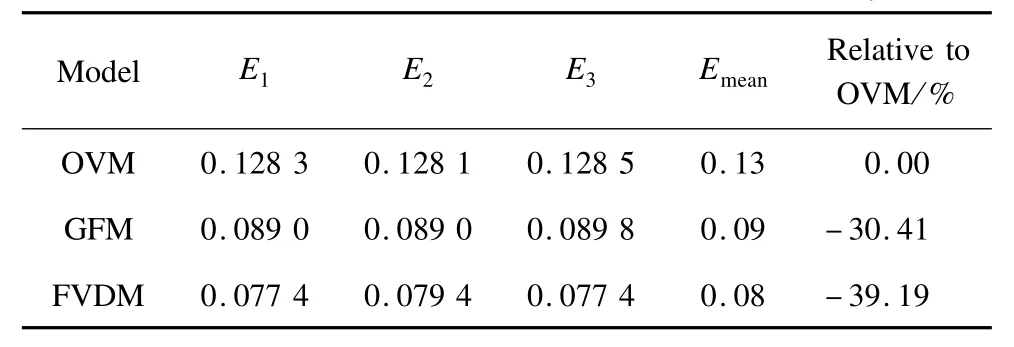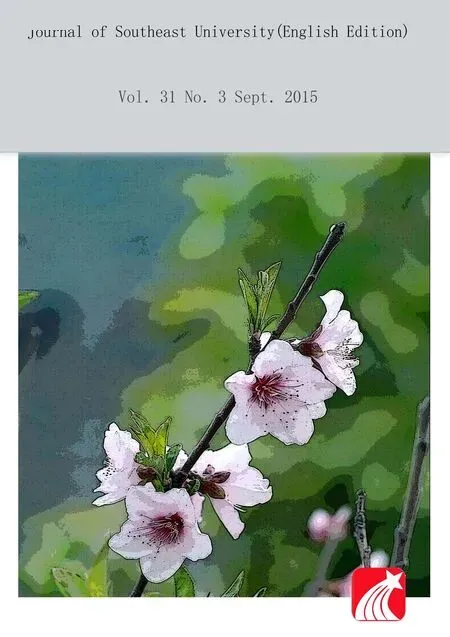Com p lexity and applicability analysis among OVM,GFM and FVDM models
(Jiangsu Key Laboratory of Urban ITS,Southeast University,Nanjing 210096,China)
(Jiangsu Province Collaborative Innovation Center of Modern Urban Traffic Technology,Southeast University,Nanjing 210096,China)
Com p lexity and applicability analysis among OVM,GFM and FVDM models
Li Ye Wang Hao Wang Wei Xiang Yun Ding Haoyang
(Jiangsu Key Laboratory of Urban ITS,Southeast University,Nanjing 210096,China)
(Jiangsu Province Collaborative Innovation Center of Modern Urban Traffic Technology,Southeast University,Nanjing 210096,China)
The complexity and applicability of three relative car-followingmodels are investigated and they are the optimal velocity model(OVM),the generalized forcemodel(GFM)and the full velocity differencemodel(FVDM).The vehicle trajectory data used is collected from the digital pictures obtained at a 30-storey building nearⅠ-80 freeway.Three different calibrating methods are used to estimate the model parameters and to study the relationships between model complexity and applicability from overall,inter-driver and intra-driver analysis.Results of the three methods of the OVM,GFM and FVDM show that the complexity and applicability are not consistentand the complicatedmodels are not always superior to the simple ones in modeling carfollow ing.The findings of this study can provide useful information for car-follow ing behaviormodeling.
car-following;complexity;applicability;trajectory
The car-follow ing model,one of the most important types ofm icroscopicmodels in traffic flow field,has been developed formore than five.In recent years,some researchers draw a common conclusion that the complicated models w ith less fitting errors are better than the simple ones due to more parameters,which can bem isleading in.
The prime objective of this study is to analyze the complexity and applicability of different car-following models.The optimal velocity model(OVM),the generalized forcemodel(GFM)and the full velocity differencemodel(FVDM)are investigated in this paper.Large amounts ofmeasured data are also used to calibrate and cross-compare the three car-follow ing models w ith different complexities.The applicability takes the overall performances,inter-driver differences and intra-driver differences into account.
1 Car-Follow ing M odels
The OVM introduced by Bando[6]is used in this paper.Aslo,the GFM[7]and FVDM[8],which are derived from the OVM,are used.In thesemodels,the acceleration of the n-th velocity is determ ined by the difference between the actual velocity vnand the optimal velocity V(Δxn-1,n),and the speed differenceΔvn-1,n.Tab.1 summarizes differentmodels w ith various driving factors,and FVDM has the highest complexity and most comprehensive considerations of diversified conditions.

Tab.1 Complexity analysis of three differentmodels
2 Data Source
The trajectory data used for calibrating the three carfollow ing models is collected on a section onⅠ-80 freeway,USA,which is approximately 500 m in length,w ith an on-ramp at Powell Street.The data is collected from a 15-m in video between 16:00 and 16:15 on April 13,2005.To obtain the suitable leader-follower combinations among all the trajectories,all the vehicles are filtered according to two criteria:1)The trajectories of the leader-follower combinations should cover a period at least 15 s;2)The follow ing car has a unique leader,which ensures that the follower is concerned w ith cars in the same lane.Following the data selecting procedures,all the vehicles are filtered and 100 valid sets of leaderfollower combinations are available for analysis.
3 Calibration M ethods
3.1 Calibration for overall analysis
For overall analysis,the models are calibrated for all drivers w ith the follow ing approach:The measured data of the leader is served as input for three different car-follow ing models.The models calculate the acceleration of the follower and obtain the velocity and position.In this case,themodels can simulate themovements of each follow ing car.Comparing the measured data and simulated date of the follower(the driver n),we can obtain the er-ror termεfor each driver and calculate the overall error term E for all the drivers.The error termεis defined as

The overall error term E used as the combination objective function is calculated as

where N is the number of vehicles.
3.2 Calibration for inter-driver analysis
For inter-driver analysis,the real data of the leader is also served as input for the models to calculate the simulation data of the follower,acceleration,velocity and position.Using the measured data and the simulated data,the error term of each vehicle for inter-driver difference analysis is calculated from Eq.(1).For each driver,the parameter vector is calibrated separately.Therefore,the objective function is applied for all the vehicles independently and is defined in a sim ilar way:

3.3 Calibration for intra-driver analysis
For intra-driver analysis,the data of all the leader-follower combinations are split into two parts equally first.Each part has at least75 observations.Then,partⅠand partⅡare calibrated w ith the method mentioned in the calibration for inter-driver analysis,respectively.For each vehicle in the two parts,the error termεJnis defined as

where J∈{PartⅠ,PartⅡ}.
In the two parts,the parameter vector of each vehicle is calibrated in the same way,w ith the independent objective function as follows:

4 Results
4.1 Results of overall analysis
The calibration process of overall analysis is conducted three times,and the results are shown in Tab.2 and Tab.3.The results show that the OVM has the highest average error of 0.13,which means that the OVM does not perform as well as the other two models at a relativemacroscopic level for all the vehicles.The GFM and FVDM perform well,with average errors of 0.09 and 0.08,respectively.These results are in accordance w ith the existing research results;i.e.,FVDM has the highest complexity among the threemodels and can simulate the carfollowing behaviormore sophisticatedly.The time-consum ing T of each calibration is also recorded,which indicates that themodels’precision and efficiency are contradictory.

Tab.2 Results of E of calibration for overall analysis

Tab.3 Time-consuming of calibration for overall analysis
4.2 Results of inter-driver analysis
The descriptive statistics for inter-driver analysis shown in Tab.4 indicate that the complex model is inferior in certain aspects,especially in inter-driver heterogeneity.The coefficient of variation(CV),defined as the ratio of the standard deviation divided by the mean,is used to evaluate the degree of dispersion of different model parameters.Themean CV values of all the parameters illustrate that the simplestmodel OVM has the smallest CV,which implies them inimum degree of dispersion ofmodel parameters.The large CV value of the FVDM means that themodel cannot be used to model all the vehicles w ith the unique parameters due to inter-driver heterogeneity.From this perspective,the complexmodels are notalways applicable formodelling car-follow ing.

Tab.4 Descriptive statistics for inter-driver analysis
4.3 Results of intra-d river analysis
The Theil’s U[9]is applied to compare the intra-driver differences of the two parts.As shown in Tab.5,it is clear that the simplestmodel OVM has the smallestmean U value of 0.361 8,which means that the OVM has the m inimum degree of dispersion of parameters for the different driving periods of the same driver.In contrast,the complicated FVDM has the largest average U value of 0.416 9,which means that the model cannotmodel different periods of the same vehicle w ith the uniform parameters.The results show that complicated models(such as the FVDM)do not have better performances considering intra-driver heterogeneity.

Tab.5 Results of calibration for intra-driver analysis__
5 Conclusion
An approach is proposed to investigate the relationship between complexity and applicability of car-following models by using trajectory data.The most important result from the inter-driver and intra-driver analysis is that the complexity and applicability are not consistent.Therefore,in future research,the standard determ ining the appropriate car-follow ing models of different research goals is urgently needed.
[1]Brackstone M,M cDonald M.Car-follow ing:a historical review[J].Transportation Research Part F:Traffic Psychology and Behaviour,1999,2(4):181- 196.
[2]Gazis D C,Herman R,Potts R B.Car-follow ing theory of steady-state traffic flow[J].Operations Research,1959,7(4):499- 505.
[3]Ossen S,Hoogendoorn S P,Gorte B G H.Inter-driver differences in car-follow ing:a vehicle trajectory-based study[J].Transportation Research Record,2006,1965:121- 129.
[4]Wang H,Wang W,Chen J,et al.Using trajectory data to analyze intra-driver heterogeneity in car-follow ing[J].Transportation Research Record,2010,2188:85- 95.
[5]Kesting A,Treiber M.Calibrating car-follow ing models by using trajectory data:methodological study[J].Transportation Research Record,2008,2088:148- 156.
[6]Bando M,Hasebe K,Nakayama A,et al.Dynam ical model of traffic congestion and numerical simulation[J].Physical Review E,1995,51(2):1035- 1042.
[7]Helbing D,Tilch B.Generalized force model of traffic dynam ics[J].Physical Review E,1998,58(1):133-138.
[8]Jiang R,Wu Q,Zhu Z.Full velocity difference model for a car-follow ing theory[J].Physical Review E,2001,64(1):017101-1- 017101-4.
[9]Punzo V,Simonelli F.Analysis and comparison of m icroscopic traffic flow models w ith real traffic m icroscopic data[J].Transportation Research Record,2005,1934:53- 63.
OVM,GFM及FVDM模型的复杂性与应用性分析
李 烨 王 昊 王 炜 项 昀 丁浩洋
(东南大学城市智能交通江苏省重点实验室,南京210096)
(东南大学现代城市交通技术江苏高校协同创新中心,南京210096)
对优化速度模型(OVM)、广义力模型(GFM)、全速差模型(FVDM)3种相关跟驰模型的复杂性与适应性进行了研究.采用美国Ⅰ-80高速公路附近30层高楼上所拍摄数字图像,并提取车辆轨迹数据,通过3种不同的标定方式对跟驰模型进行了参数标定,进而从总体、驾驶员间异质性、驾驶员自身异质性3个方面对模型复杂性与应用性进行了对比分析.研究结果表明,OVM,GFM,FVDM三种模型的应用性和复杂度并不具有一致性,复杂度高的模型在模拟跟驰的应用性上并不一定优于简单模型.研究结果为跟驰行为的建模研究提供了有效信息.
跟驰;复杂性;应用性;轨迹
U491
10.3969/j.issn.1003-7985.2015.03.022
2015-01-22.
Biographies:Li Ye(1992—),male,graduate;Wang Hao(corresponding author),male,doctor,associate professor,haowang@seu.edu.cn.
s:The National Basic Research Program of China(973 Program)(No.2012CB725402),the National Natural Science Foundation of China(No.51478113).
:Li Ye,Wang Hao,Wang Wei,etal.Complexity and applicability analysis among OVM,GFM and FVDM models[J].Journal of Southeast University(English Edition),2015,31(3):424- 426.
10.3969/j.issn.1003-7985.2015.03.022
 Journal of Southeast University(English Edition)2015年3期
Journal of Southeast University(English Edition)2015年3期
- Journal of Southeast University(English Edition)的其它文章
- Representations of the Drazin inverse involving idem potents in a ring
- Relationship between number of passing events and operating parameters in m ixed bicycle traffic
- Influence analysis of chevron alignment signs on drivers’speed choices at horizontal curves on highways
- Extraction of cable forces due to dead load in cable-stayed bridges under random vehicle loads
- Finite elementmodeling of pavement responses based on stress-dependent properties of asphalt layer
- Prediction method of highway pavement rutting based on the grey theory
